
-----
Pitting in plating process
Q. We are a manufacturer of hydraulic tubing and have been experiencing problems with the hydraulic fittings we purchase. After brazing and pickling we send the parts out for plating. In the past only parts that went through a furnace braze process experienced the pitted corrosion (sporadically). Recently additional parts started having the same pitting. Corrosion is particularly evident in the o-ring grooves and threading.
Good part, followed by bad part
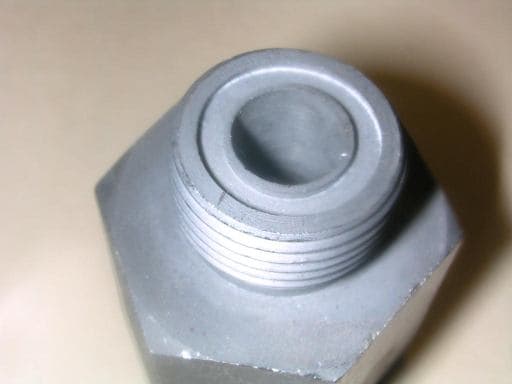
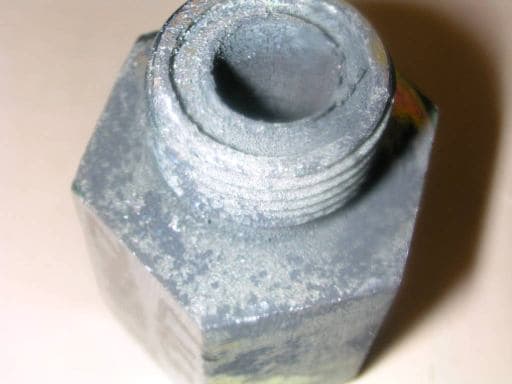
The fittings are made from a standard 1045 (previous supplier used 12L14). Some come through the process great, others have the pit corrosion and there is no rhyme or reason to it. Does anyone have any suggestions how to test failed parts to determine what has happened?
Hydraulic Tubing manufacturing - Milwaukee, Wisconsin USA
2005
A. Hi Eric,
I'm happy to see that you have sent a picture for us to go by. I think this will help resolve your issue.
First, as a barrel plater, I would not be having a good day if I held those pitting parts in my hand. I would be concerned about incorrect steps I may have taken to pre-clean or strip these parts.
It seems that your plater possibly used a nitric strip or perhaps little or no cyanide strike (or a Ni strike in some shops) prior to an acid Cu plate? Using or over using an incorrect or too strong pickle to remove any heat treat could also result in the look of the parts in the picture. And hearing that the parts are 1045 parts would lead me to believe that the preplate process may need to be adjusted from the typical process for most steel parts
I really hope that some of the info I have provided will help you to resolve your plating issue and I would really look forward to seeing more input from others in the forum.
Please let us know the results so that we can all learn something.
Good luck!
- Barrel Plater Methuen, Massachusetts, U.S.A.
Q. Overall process -
1. Degrease parts with a drip dry process
2. Copper / Silver braze parts
(some are manually brazed some are furnace brazed, there has been no consistency on which the problem occurs)
3) Pickle parts
4) Rinse
5) Send out for plating
We have had some problems found at all stages of the process. The parts will run fine for months and suddenly will start having sporadic problems.
Is there anything in the metal (1045) that could change that would create this problem? Would surface texture or minor changes in chemistry affect our process significantly enough to cause these issues to appear?
- Wisconsin
A. I agree with Eric, nasty looking.
Has the product been quenched at all after heat heating.
Your plater might be having trouble cleaning the articles and leaving it in the acid too long.
Is he using any sulfuric based cleaners at all in his line? I had a similar problem once and it was the sulfuric cleaner. (you will not see the pitting after the sulfuric)
Try not to pickle it before it goes to the platers. Let them handle all the cleaning.
If they can let them send it for cleaning to someone who can put it into a tumbler or vibrator with PLENTY of rough glass beads. It will take all surface muck off (this must be done wet).

Gary Joseph
Johannesburg,
South Africa
Q. Hi all,
Pit marks are the defect I have to ask suggestions about --
We do Zinc Iron white passivation on fasteners, especially on bolts that also in shank portion are un-threaded. The pit marks are noticed. Base Material is boron steel. Manufactured by cold forging. Alkaline Zinc Iron plating process.
Are pit marks a common defect in fasteners? If yes, will it affect the performance compared to non pit marked fasteners.
Thanking you for the responses.
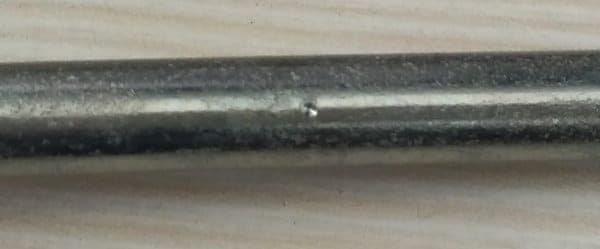
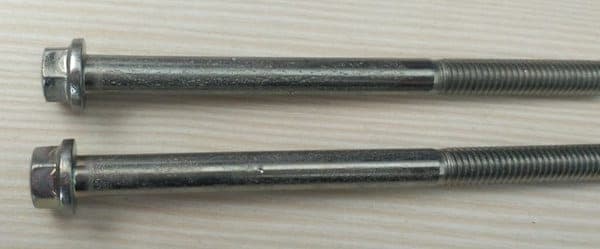
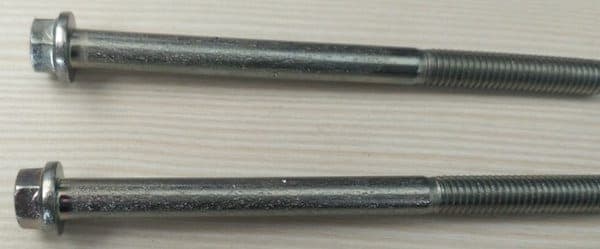
- CHENNAI, Tamil Nadu, India
May 19, 2017
A. Hi Kesavaram. I'm not sure of the scale of the photos but the pit in the first photo looks incredibly large to be a plating pit rather than something inflicted mechanically :-(
Assuming that it is in fact a pit from the plating process, then it seems to be a gas pit from the brightness and what appears to be a hemispherical shape. Better agitation and lower plating bath surface tension are the usual resolution to gas pits.
The answer to the question of whether it will affect the performance is that unexplained random defects may affect the performance in unexplained random ways and are not acceptable.
Luck & Regards,

Ted Mooney, P.E. RET
Striving to live Aloha
finishing.com - Pine Beach, New Jersey
Ted is available for instant help
or longer-term assistance.
Q, A, or Comment on THIS thread -or- Start a NEW Thread